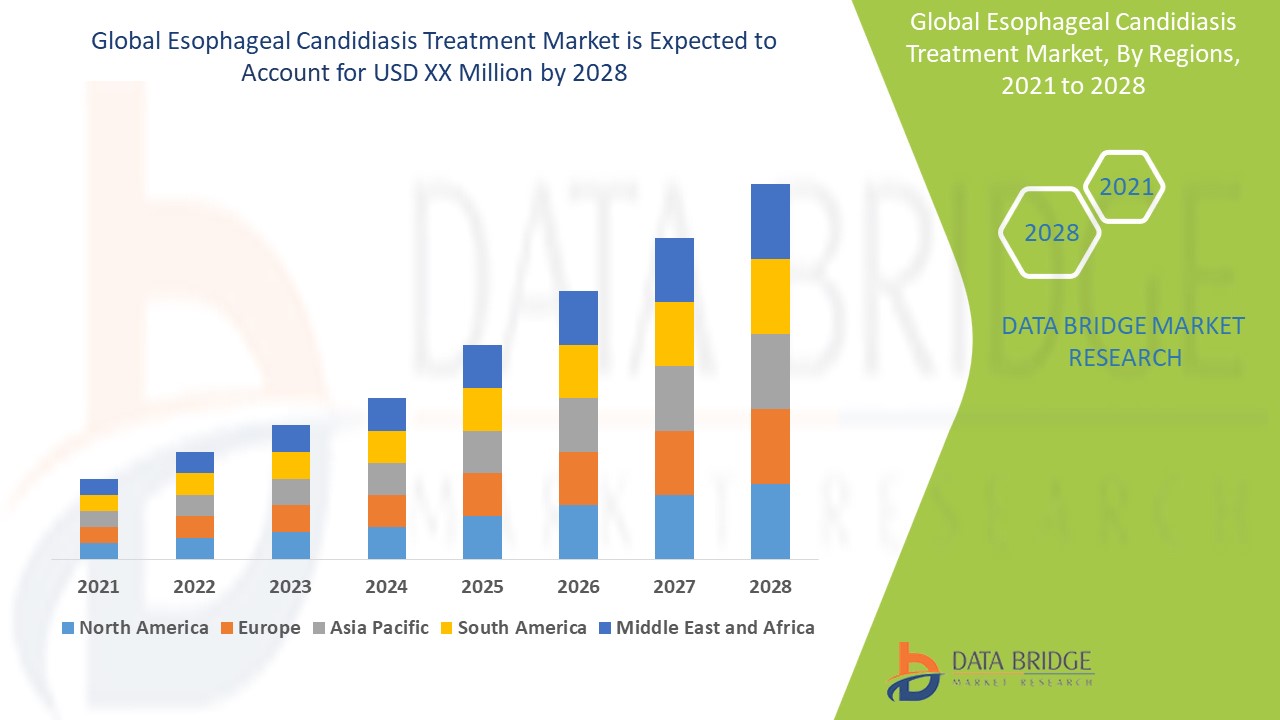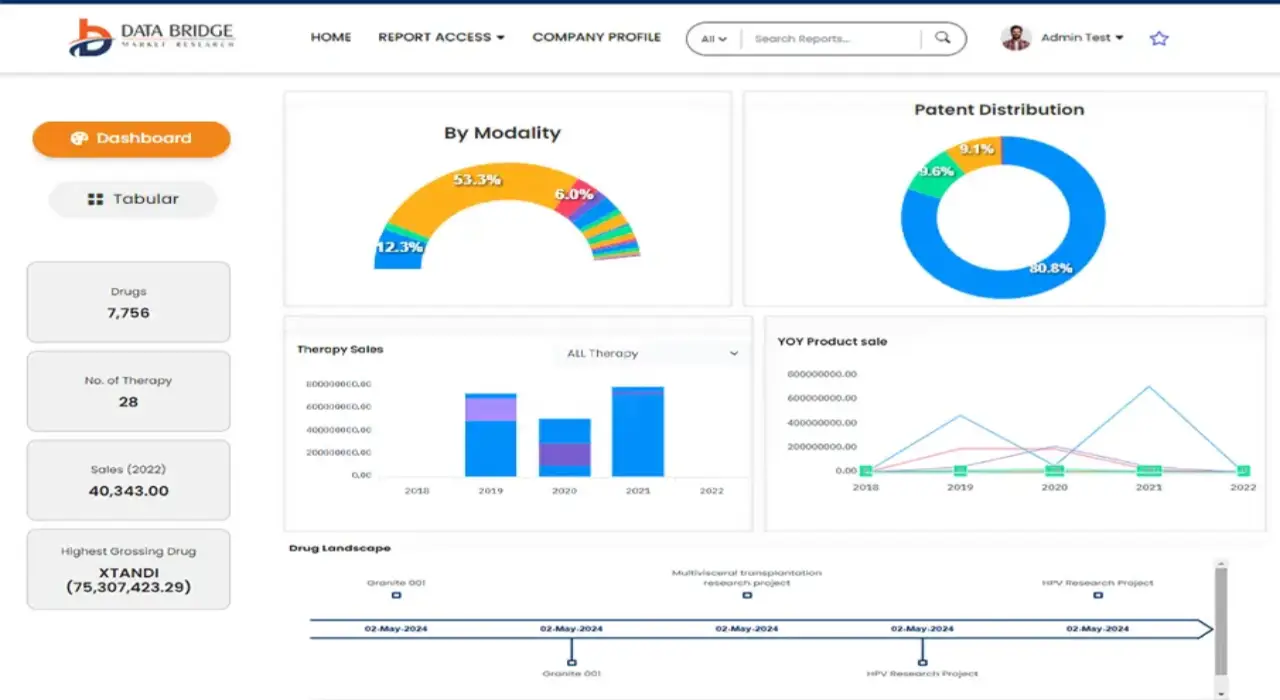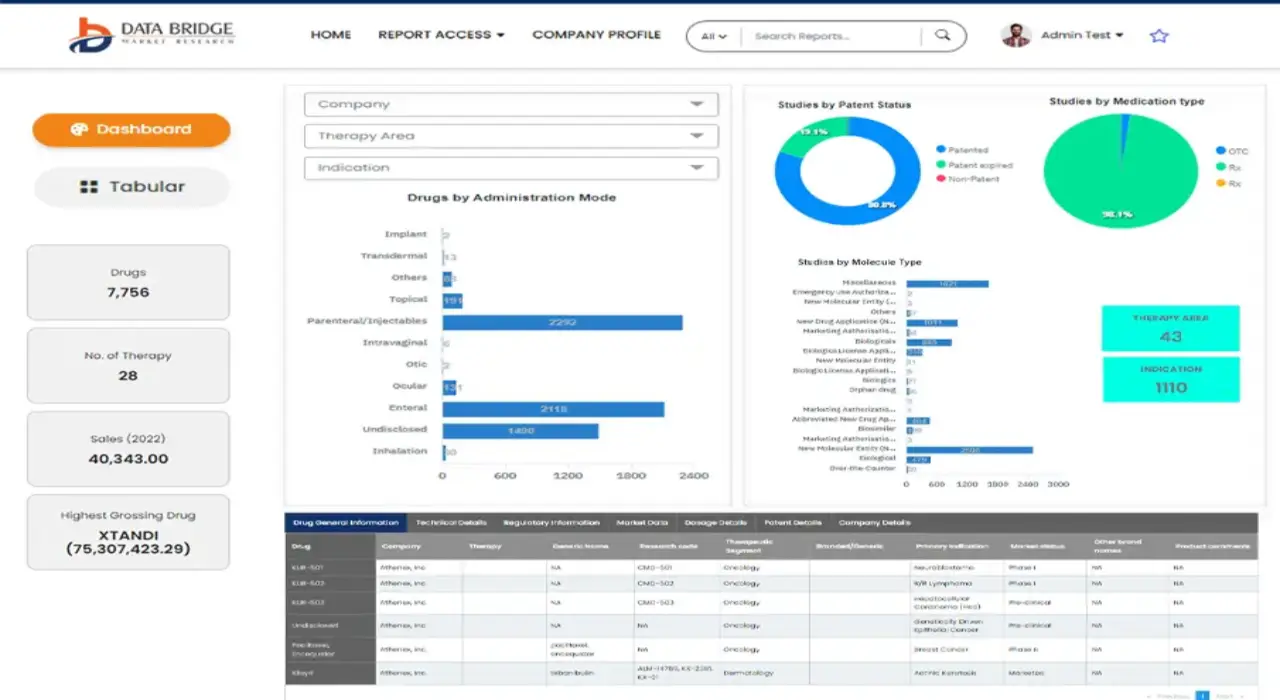Global Esophageal Candidiasis Treatment Market
Market Size in USD Million
CAGR :
% 
 USD
129.84 Million
USD
212.80 Million
2024
2031
USD
129.84 Million
USD
212.80 Million
2024
2031
| 2025 –2031 | |
| USD 129.84 Million | |
| USD 212.80 Million | |
|
|
|
|
Global Esophageal Candidiasis Treatment Market Segmentation, By Treatment (Diagnosis, Medication, and Others), Route of Administration (Oral and Parenteral), End-Users (Hospitals, Specialty Clinics, Home Healthcare, and Others), Distribution Channel (Direct Tender, Hospital Pharmacy, Retail Pharmacy, Online Pharmacy, and Others) – Industry Trends and Forecast to 2032
Esophageal Candidiasis Treatment Market Analysis
The esophageal candidiasis treatment market has seen significant advancements, particularly in antifungal therapies. Novel triazole antifungals such as isavuconazole offer enhanced efficacy with reduced toxicity, catering to immunocompromised patients. Liposomal formulations of amphotericin B provide targeted drug delivery, minimizing systemic side effects and improving patient compliance. Diagnostic tools such as PCR-based assays and MALDI-TOF mass spectrometry enable rapid and precise identification of Candida species, ensuring timely and effective treatment.
Biopharmaceutical advancements include monoclonal antibodies targeting fungal virulence factors, promising more specific interventions. The use of artificial intelligence (AI) in drug discovery accelerates the development of novel antifungal agents. Telemedicine platforms enhance access to early diagnosis and treatment, especially in remote areas.
Market growth is driven by rising incidences of immunosuppressive conditions, including cancer and HIV, along with increasing awareness about fungal infections. Emerging economies contribute significantly due to improved healthcare infrastructure. As research continues, the integration of precision medicine and personalized therapies is expected to further boost the esophageal candidiasis treatment market, ensuring better patient outcomes.
Esophageal Candidiasis Treatment Market Size
The global esophageal candidiasis treatment market size was valued at USD 129.84 million in 2024 and is projected to reach USD 212.80 million by 2032, with a CAGR of 6.37% during the forecast period of 2025 to 2032. In addition to the insights on market scenarios such as market value, growth rate, segmentation, geographical coverage, and major players, the market reports curated by the Data Bridge Market Research also include depth expert analysis, patient epidemiology, pipeline analysis, pricing analysis, and regulatory framework.
Esophageal Candidiasis Treatment Market Trends
“Increasing Adoption of Antifungal Combination Therapies”
A key trend driving growth in the esophageal candidiasis treatment market is the increasing adoption of antifungal combination therapies. These therapies, which integrate azoles such as fluconazole with echinocandins such as caspofungin, are proving effective in managing resistant or severe cases. This approach minimizes drug resistance, improves patient outcomes, and reduces recurrence rates. For instance, studies published in leading medical journals highlight the enhanced efficacy of combining fluconazole and micafungin in refractory esophageal candidiasis cases. This trend is gaining traction in regions with high incidence rates of fungal infections, particularly among immunocompromised patients, further bolstering market demand and encouraging pharmaceutical companies to invest in advanced combination treatments.
Report Scope and Esophageal Candidiasis Treatment Market Segmentation
|
Attributes |
Esophageal Candidiasis Treatment Key Market Insights |
|
Segments Covered |
|
|
Countries Covered |
U.S., Canada and Mexico in North America, Germany, France, U.K., Netherlands, Switzerland, Belgium, Russia, Italy, Spain, Turkey, Rest of Europe in Europe, China, Japan, India, South Korea, Singapore, Malaysia, Australia, Thailand, Indonesia, Philippines, Rest of Asia-Pacific (APAC) in the Asia-Pacific (APAC), Saudi Arabia, U.A.E, South Africa, Egypt, Israel, Rest of Middle East and Africa (MEA) as a part of Middle East and Africa (MEA), Brazil, Argentina and Rest of South America as part of South America |
|
Key Market Players |
GSK plc (U.K.), Pfizer Inc. (U.S.), Viatris (U.S.), Macleods Pharmaceuticals (India), Cadila Pharmaceuticals (India), Johnson & Johnson Services, Inc. (U.S.), Teva Pharmaceutical Industries Ltd. (Israel), Bayer AG (Germany), Sun Pharmaceutical Industries Ltd. (India), Perrigo Pharmaceutical plc. (Ireland), Sandoz AG (Switzerland), and Hikma Pharmaceutical PLC (U.K.) |
|
Market Opportunities |
|
|
Value Added Data Infosets |
In addition to the insights on market scenarios such as market value, growth rate, segmentation, geographical coverage, and major players, the market reports curated by the Data Bridge Market Research also include depth expert analysis, patient epidemiology, pipeline analysis, pricing analysis, and regulatory framework. |
Esophageal Candidiasis Treatment Market Definition
Esophageal candidiasis is typically treated with antifungal drugs. Oral fluconazole, a triazole antifungal, is the first-line therapy due to its effectiveness and convenience. For severe cases or when oral administration isn't feasible, intravenous echinocandins such as caspofungin or micafungin may be used. Amphotericin B is an option for resistant infections. Patients with underlying conditions, such as HIV/AIDS, often require prolonged therapy. Maintaining oral hygiene and managing risk factors, such as immunosuppression or uncontrolled diabetes, are critical for prevention and recurrence reduction. In persistent cases, a biopsy or culture is conducted to confirm the diagnosis and adjust the treatment plan.
Esophageal Candidiasis Treatment Market Dynamics
Drivers
- Rising Incidence of Immunosuppressive Conditions
The growing prevalence of immunosuppressive conditions, such as HIV/AIDS, cancer, and organ transplants, is significantly driving the esophageal candidiasis treatment market. These conditions weaken the immune system, increasing susceptibility to opportunistic infections such as esophageal candidiasis. For instance, the World Health Organization (WHO) reports that nearly 38 million people live with HIV globally, with a substantial portion at risk for fungal infections. Similarly, the rising number of cancer patients undergoing chemotherapy or organ transplant recipients taking immunosuppressants contributes to higher infection rates. This growing patient base amplifies the demand for antifungal treatments, fostering market expansion and encouraging the development of more targeted and effective therapies.
- Increasing Use of Immunosuppressive Therapies
The rising use of immunosuppressive therapies for managing autoimmune diseases, organ transplants, and cancer is significantly driving the esophageal candidiasis treatment market. These therapies, while crucial for controlling overactive immune responses, often weaken the body's natural defenses, making patients more susceptible to opportunistic infections such as esophageal candidiasis. With the growing prevalence of autoimmune disorders such as rheumatoid arthritis and inflammatory bowel disease, alongside advancements in cancer treatments, the demand for antifungal medications is escalating. In addition, the adoption of targeted immunotherapies, which may inadvertently suppress immunity, further accentuates the risk of fungal infections, creating a robust need for effective treatments in this market segment.
Opportunities
- Development of Antifungal Medications
The development of advanced antifungal medications presents significant opportunities in the esophageal candidiasis treatment market. Innovations in oral and intravenous (IV) antifungal formulations enhance treatment efficacy and cater to diverse patient needs, improving compliance. For instance, newer azole antifungals and echinocandins offer broader spectrums of activity and fewer side effects, addressing drug-resistant Candida strains effectively. In addition, the focus on once-daily dosing and user-friendly formulations simplifies treatment regimens. Companies investing in research and development of such drugs can capitalize on the growing demand for improved therapies, especially in regions with high rates of immunosuppressive conditions. These advancements position antifungal drugs as a key growth driver in the healthcare sector.
- Adoption of Combination Therapies
The adoption of combination therapies is emerging as a significant trend in the esophageal candidiasis treatment market. These therapies, which involve the use of multiple antifungal agents, are particularly effective in severe and resistant cases where monotherapy might fail. By enhancing treatment efficacy and reducing relapse rates, combination therapies cater to unmet medical needs, creating opportunities for pharmaceutical companies to develop innovative drug regimens. For instance, the use of azoles with echinocandins has shown promising results in clinical settings. As drug resistance becomes a growing concern, healthcare providers increasingly rely on these advanced approaches, driving market growth and fostering research in novel antifungal combinations.
Restraints/Challenges
- High Treatment Costs
High treatment costs for esophageal candidiasis, especially in drug-resistant cases, significantly hinder market growth. Advanced therapies, such as newer antifungal drugs and combination treatments, come with a hefty price tag, making them inaccessible to economically weaker populations. The financial burden is compounded by the need for prolonged treatment in severe cases, which increases the overall cost. This disparity in access to effective treatment creates a gap between patient populations, especially in low-income regions where healthcare resources are limited. As a result, many patients may resort to suboptimal treatments, delaying recovery and contributing to a higher incidence of complications, further straining healthcare systems.
- Side Effects of Antifungal Therapies
Side effects of antifungal therapies, such as liver toxicity and gastrointestinal disturbances, significantly hinder the esophageal candidiasis treatment market. Common adverse reactions include nausea, vomiting, diarrhea, and abdominal pain, which can discourage patient compliance. Liver toxicity, particularly with prolonged use of drugs such as fluconazole, may lead to more serious conditions such as liver failure, requiring close monitoring. These side effects not only affect treatment adherence but also contribute to increased healthcare costs due to the need for additional management of adverse reactions. As a result, many patients discontinue or delay treatment, ultimately impacting the overall effectiveness of available therapies and limiting market growth.
This market report provides details of new recent developments, trade regulations, import-export analysis, production analysis, value chain optimization, market share, impact of domestic and localized market players, analyses opportunities in terms of emerging revenue pockets, changes in market regulations, strategic market growth analysis, market size, category market growths, application niches and dominance, product approvals, product launches, geographic expansions, technological innovations in the market. To gain more info on the market contact Data Bridge Market Research for an Analyst Brief, our team will help you take an informed market decision to achieve market growth.
Esophageal Candidiasis Treatment Market Scope
The market is segmented on the basis of treatment, route of administration, end-users and distribution channel. The growth amongst these segments will help you analyze meagre growth segments in the industries and provide the users with a valuable market overview and market insights to help them make strategic decisions for identifying core market applications.
Treatment
- Diagnosis
- Imaging Test
- Histopathology Test
- Others
- Medication
- Antifungal
- Fluconazole
- Micafungin
- Itraconazole
- Voriconazole
- Amphotericin B Deoxycholate
- Posaconazole
- Others
- Antifungal
- Others
Route of Administration
- Oral
- Parenteral
End-Users
- Hospitals
- Specialty Clinics
- Home Healthcare
- Others
Distribution Channel
- Direct Tender
- Hospital Pharmacy
- Retail Pharmacy
- Online Pharmacy
- Others
Esophageal Candidiasis Treatment Market Regional Analysis
The market is analysed and market size insights and trends are provided by country, treatment, route of administration, end-users and distribution channel as referenced above.
The countries covered in the market report are U.S., Canada, Mexico in North America, Germany, Sweden, Poland, Denmark, Italy, U.K., France, Spain, Netherland, Belgium, Switzerland, Turkey, Russia, Rest of Europe in Europe, Japan, China, India, South Korea, New Zealand, Vietnam, Australia, Singapore, Malaysia, Thailand, Indonesia, Philippines, Rest of Asia-Pacific (APAC) in Asia-Pacific (APAC), Brazil, Argentina, Rest of South America as a part of South America, U.A.E, Saudi Arabia, Oman, Qatar, Kuwait, South Africa, Rest of Middle East and Africa (MEA) as a part of Middle East and Africa (MEA)
North America is expected to dominate the esophageal candidiasis treatment market due to the region's high healthcare expenditure and extensive clinical research efforts focused on treatment options. The presence of well-established healthcare facilities, advanced medical infrastructure, and favorable reimbursement policies further contribute to market growth. In addition, the rising prevalence of esophageal candidiasis and increasing awareness about its treatments drive the demand for innovative therapeutic solutions in the region.
Asia-Pacific is expected to show significant growth in the esophageal candidiasis treatment market due to the rising incidence of the condition in the region. The increasing demand for cost-efficient therapeutics, coupled with improved healthcare access, is expected to drive market growth. Furthermore, the growing awareness about esophageal candidiasis and the availability of affordable treatment options contribute to the region's dominance in the market over the coming years.
The country section of the report also provides individual market impacting factors and changes in regulation in the market domestically that impacts the current and future trends of the market. Data points such as down-stream and upstream value chain analysis, technical trends and porter's five forces analysis, case studies are some of the pointers used to forecast the market scenario for individual countries. Also, the presence and availability of global brands and their challenges faced due to large or scarce competition from local and domestic brands, impact of domestic tariffs and trade routes are considered while providing forecast analysis of the country data.
Esophageal Candidiasis Treatment Market Share
The market competitive landscape provides details by competitor. Details included are company overview, company financials, revenue generated, market potential, investment in research and development, new market initiatives, global presence, production sites and facilities, production capacities, company strengths and weaknesses, product launch, product width and breadth, application dominance. The above data points provided are only related to the companies' focus related to market.
Esophageal Candidiasis Treatment Market Leaders Operating in the Market Are:
- GSK plc (U.K.)
- Pfizer Inc. (U.S.)
- Viatris (U.S.)
- Macleods Pharmaceuticals (India)
- Cadila Pharmaceuticals (India)
- Johnson & Johnson Services, Inc. (U.S.)
- Teva Pharmaceutical Industries Ltd. (Israel)
- Bayer AG (Germany)
- Sun Pharmaceutical Industries Ltd. (India)
- Perrigo Pharmaceutical plc. (Ireland)
- Sandoz AG (Switzerland)
- Hikma Pharmaceutical PLC (U.K.)
Latest Developments in Esophageal Candidiasis Treatment Market
- In August 2022, Mycovia Pharmaceuticals, Inc. presented topline results from two studies on VIVJOA (Oteseconazole) capsules for recurrent vulvovaginal candidiasis (RVVC). The studies evaluated the drug’s effectiveness and safety in treating RVVC, showing promising results for a new therapeutic option for patients with this persistent and difficult-to-treat condition
- In August 2022, VIVJOA (Oteseconazole), an oral antifungal drug developed by Mycovia Pharmaceuticals, received FDA approval. This drug selectively inhibits fungal CYP5, marking a significant advancement in treating recurrent vulvovaginal candidiasis (RVVC). It offers a new treatment option for women suffering from this chronic condition, helping address the unmet medical needs of patients
- In June 2021, Scynexis, Inc. announced that their novel antifungal drug, BREXAFEMME (Ibrexafungerp), received FDA approval for treating vulvovaginal candidiasis (VVC). This oral treatment provides a new option for managing VVC, offering a distinct mechanism of action compared to other therapies. The approval highlighted Scynexis’s commitment to addressing unmet needs in women’s health
SKU-
Get online access to the report on the World's First Market Intelligence Cloud
- Interactive Data Analysis Dashboard
- Company Analysis Dashboard for high growth potential opportunities
- Research Analyst Access for customization & queries
- Competitor Analysis with Interactive dashboard
- Latest News, Updates & Trend analysis
- Harness the Power of Benchmark Analysis for Comprehensive Competitor Tracking
Research Methodology
Data collection and base year analysis are done using data collection modules with large sample sizes. The stage includes obtaining market information or related data through various sources and strategies. It includes examining and planning all the data acquired from the past in advance. It likewise envelops the examination of information inconsistencies seen across different information sources. The market data is analysed and estimated using market statistical and coherent models. Also, market share analysis and key trend analysis are the major success factors in the market report. To know more, please request an analyst call or drop down your inquiry.
The key research methodology used by DBMR research team is data triangulation which involves data mining, analysis of the impact of data variables on the market and primary (industry expert) validation. Data models include Vendor Positioning Grid, Market Time Line Analysis, Market Overview and Guide, Company Positioning Grid, Patent Analysis, Pricing Analysis, Company Market Share Analysis, Standards of Measurement, Global versus Regional and Vendor Share Analysis. To know more about the research methodology, drop in an inquiry to speak to our industry experts.
Customization Available
Data Bridge Market Research is a leader in advanced formative research. We take pride in servicing our existing and new customers with data and analysis that match and suits their goal. The report can be customized to include price trend analysis of target brands understanding the market for additional countries (ask for the list of countries), clinical trial results data, literature review, refurbished market and product base analysis. Market analysis of target competitors can be analyzed from technology-based analysis to market portfolio strategies. We can add as many competitors that you require data about in the format and data style you are looking for. Our team of analysts can also provide you data in crude raw excel files pivot tables (Fact book) or can assist you in creating presentations from the data sets available in the report.













